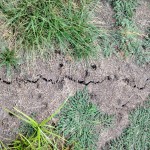This was a post from last May on the old blog that I thought I would repost so everyone had the information for this year!
(By Ward Upham and Jared Hoyle, KSU Extension)

Yellow nutsedge is a relatively common problem in lawns, especially in wet years or in lawns with irrigation. Although it looks much like a grass, it is a sedge. Unlike grasses, sedges have triangular stems, and the leaves are three-ranked instead of two-ranked, which means the leaves come off the stems in three different directions. Yellow nutsedge is pale green to yellow and grows rapidly in the spring and early summer. Because of this rapid shoot growth, it sticks up above the rest of the lawn only a few days after mowing. This weed is a good indicator of poor drainage, but it can be introduced into well-drained sites through contaminated topsoil or nursery stock. As with many weeds, nutsedge is less competitive in a dense, healthy lawn than in an open, poor lawn.
Nutsedge is difficult to control culturally because it produces numerous tubers that give rise to new plants. Pulling nutsedge will increase the number of plants because dormant tubers are activated. However, it is possible to control nutsedge by pulling, but you must be persistent. If you are, eventually the nutsedge will die out.
If you were going to treat with an herbicide, it would be better to leave the nutsedge plants undisturbed so the herbicide can be maximally translocated to the roots, rhizomes, and tubers. Several herbicides are available for nutsedge control. Sedge Hammer, which used to be called Manage, is the most effective and safe for most turfgrasses. It is also the most expensive, but if an infestation is not too severe, one application should take care of the problem. The Sedge Hammer label says to apply it after nutsedge has reached the three- to eight-leaf stage. Waiting until this growth stage apparently results in improved translocation of the active ingredient to the underground tubers and rhizomes. However, research has shown that the application should go down by June 21. If the initial spray is after June 21, mature daughter tubers may be stimulated to grow.
Small packages of Sedge Hammer are available to homeowners. Using a non-ionic surfactant with the Sedge Hammer will give better control.
****Always remember to READ THE LABEL for the correct rate, turfgrass tolerance, and specific instructions before application.****
***Mention of trade names or commercial products in this article is solely for identification purposes and does not imply recommendation or endorsement, nor is criticism implied of similar products not mentioned by Kansas State University.***
Don’t forget to follow me on twitter @KSUTurf.
Also, visit our facebook page www.facebook.com/KSUTurf
